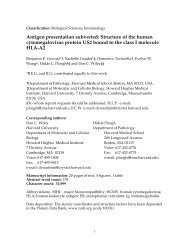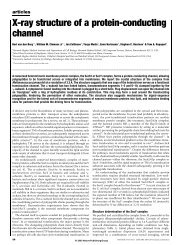Structure of the dengue virus envelope protein after membrane fusion
Structure of the dengue virus envelope protein after membrane fusion
Structure of the dengue virus envelope protein after membrane fusion
Create successful ePaper yourself
Turn your PDF publications into a flip-book with our unique Google optimized e-Paper software.
articles<br />
responsible for attachment <strong>of</strong> soluble E ectodomains to target<br />
<strong>membrane</strong>s and that <strong>the</strong> hydrophobic residues are essential for its<br />
activity 14 . These and o<strong>the</strong>r data, including results from studies <strong>of</strong><br />
alpha<strong>virus</strong>es 15,16 , which have a very similar cd-loop structure,<br />
support <strong>the</strong> view that <strong>the</strong> cd loop <strong>of</strong> class II <strong>fusion</strong> <strong>protein</strong>s has a<br />
function analogous to that <strong>of</strong> <strong>the</strong> N-terminal <strong>fusion</strong> peptide in class<br />
I <strong>fusion</strong> <strong>protein</strong>s: insertion into <strong>the</strong> host-cell <strong>membrane</strong> and<br />
provision <strong>of</strong> an attachment point for drawing host-cell and viral<br />
<strong>membrane</strong>s toge<strong>the</strong>r 1 . We refer to <strong>the</strong> cd loop as <strong>the</strong> ‘<strong>fusion</strong> loop’,<br />
reserving ‘<strong>fusion</strong> peptide’ for <strong>the</strong> N-terminal segment <strong>of</strong> class I<br />
<strong>fusion</strong> <strong>protein</strong>s.<br />
An important missing link in our picture <strong>of</strong> <strong>membrane</strong> <strong>fusion</strong> is a<br />
direct view <strong>of</strong> a <strong>fusion</strong> peptide or loop as it inserts into a target<br />
<strong>membrane</strong>. The crystal structure we describe here—<strong>of</strong> <strong>the</strong> soluble<br />
ectodomain <strong>of</strong> <strong>dengue</strong> <strong>virus</strong> type 2 E <strong>protein</strong> (sE) in its trimeric,<br />
post<strong>fusion</strong> conformation—provides such a link. The <strong>fusion</strong> loops <strong>of</strong><br />
<strong>the</strong> three subunits come toge<strong>the</strong>r to form a <strong>membrane</strong>-insertable,<br />
‘aromatic anchor’ at <strong>the</strong> tip <strong>of</strong> <strong>the</strong> trimer. The <strong>fusion</strong> loop retains its<br />
pre<strong>fusion</strong> conformation. Neighbouring hydrophilic groups restrict<br />
insertion to <strong>the</strong> proximal part <strong>of</strong> <strong>the</strong> outer lipid-bilayer leaflet. The<br />
entire ectodomain <strong>of</strong> <strong>the</strong> <strong>protein</strong> folds back on itself, directing <strong>the</strong><br />
C-terminal, viral <strong>membrane</strong> anchor towards <strong>the</strong> <strong>fusion</strong> loop.<br />
Comparison with <strong>the</strong> pre<strong>fusion</strong> structure <strong>of</strong> <strong>the</strong> same <strong>protein</strong> 10<br />
allows us to propose a mechanism for <strong>fusion</strong> driven by an essentially<br />
irreversible conformational change in <strong>the</strong> <strong>protein</strong> and assisted by<br />
<strong>membrane</strong> distortions imposed by <strong>fusion</strong>-loop insertion. Specific<br />
features <strong>of</strong> <strong>the</strong> folded-back structure suggest strategies for inhibiting<br />
flavi<strong>virus</strong> entry. The post<strong>fusion</strong> structure <strong>of</strong> an alpha<strong>virus</strong> <strong>fusion</strong><br />
<strong>protein</strong> 17 described in <strong>the</strong> accompanying paper shows an analogous<br />
conformation and leads to similar conclusions.<br />
Membrane insertion and trimer formation<br />
Like its TBE homologue, <strong>the</strong> dimer formed by <strong>dengue</strong> sE (residues<br />
1–395 <strong>of</strong> E) dissociates reversibly 10,11 . At acidic pH, dissociation is<br />
essentially complete at <strong>protein</strong> concentrations <strong>of</strong> 1 mg ml 21 ; at<br />
neutral pH, <strong>the</strong> dissociation constant is one to two orders <strong>of</strong><br />
magnitude smaller. The <strong>fusion</strong> loop at <strong>the</strong> tip <strong>of</strong> domain II would<br />
be exposed in <strong>the</strong> monomer 8,10 , but exposure does not cause nonspecific<br />
aggregation <strong>of</strong> <strong>the</strong> <strong>protein</strong> 11 . Liposome c<strong>of</strong>lotation experiments<br />
show that <strong>the</strong> <strong>fusion</strong> loop <strong>of</strong> monomeric TBE sE allows<br />
association with lipid <strong>membrane</strong>s and that this <strong>membrane</strong> association<br />
catalyses irreversible formation <strong>of</strong> sE trimers at low pH 18 .<br />
Dengue E exhibits an identical behaviour: on acidification, sE<br />
dimers dissociate, bind liposomes and trimerize (see Methods).<br />
Membrane-associated sE is readily detected by electron microscopy<br />
<strong>of</strong> negatively stained preparations (Fig. 2a); chemical cross-linking<br />
confirms that <strong>the</strong> <strong>protein</strong> has trimerized (Fig. 2b). The trimers are<br />
tapered rods, about 70–80 Å long and 30–50 Å in diameter, with <strong>the</strong><br />
long axis perpendicular to <strong>the</strong> <strong>membrane</strong> and <strong>the</strong>ir wide end distal<br />
to it. They tend to cluster on <strong>the</strong> liposome surface, <strong>of</strong>ten forming a<br />
continuous layer. These heavily decorated areas appear to have a<br />
greater than average <strong>membrane</strong> curvature, resulting in smaller<br />
vesicles (Fig. 2a). This observation suggests that E trimers can<br />
induce curvature, a property that may help promote <strong>fusion</strong> (see<br />
below). The <strong>dengue</strong> sE trimers can be solubilized with <strong>the</strong> detergent<br />
n-octyl-b-D-glucoside (b-OG); <strong>the</strong>y remain trimeric at all pH<br />
values between 5 and 9, as determined by gel filtration chromatography<br />
(data not shown).<br />
Domain rearrangements in <strong>the</strong> trimer<br />
Crystals <strong>of</strong> <strong>the</strong> detergent-solubilized <strong>dengue</strong> sE trimers diffract to<br />
high resolution (2.0 Å); <strong>the</strong> structure was determined by molecular<br />
replacement (see Methods). The three domains <strong>of</strong> sE retain most <strong>of</strong><br />
<strong>the</strong>ir folded structures, but undergo major rearrangements in <strong>the</strong>ir<br />
relative orientations, through flexion <strong>of</strong> <strong>the</strong> interdomain linkers<br />
(Fig. 3). Domain II rotates approximately 308 with respect to<br />
domain I, about a hinge near residue 191 and <strong>the</strong> kl hairpin<br />
(residues 270–279), where mutations that affect <strong>the</strong> pH threshold<br />
<strong>of</strong> <strong>fusion</strong> are concentrated 10 . As a result <strong>of</strong> <strong>the</strong> rotation, <strong>the</strong> base <strong>of</strong><br />
<strong>the</strong> kl hairpin is pulled apart, and <strong>the</strong> l strand forms a new set <strong>of</strong><br />
hydrogen bonds with <strong>the</strong> D 0 strand <strong>of</strong> domain I, shifted by two<br />
residues from <strong>the</strong> hydrogen-bonding pattern in <strong>the</strong> dimer 10 .<br />
Although detergent is present, <strong>the</strong> kl hairpin does not adopt <strong>the</strong><br />
open conformation seen in <strong>the</strong> dimer with bound b-OG 10 . The<br />
small hydrophobic core beneath this hairpin acts as a ‘greased hinge’<br />
for <strong>the</strong> rotation between domains I and II.<br />
Domain III undergoes <strong>the</strong> most significant displacement in <strong>the</strong><br />
dimer-to-trimer transition. It rotates by about 708, and its centre <strong>of</strong><br />
mass shifts by 36 Å towards domain II. This folding-over brings <strong>the</strong><br />
C terminus <strong>of</strong> domain III (residue 395) 39 Å closer to <strong>the</strong> <strong>fusion</strong><br />
loop.<br />
Changes in <strong>the</strong> secondary structure<br />
The 10-residue linker between domains I and III accommodates<br />
<strong>the</strong>ir large relative displacement during trimer formation. The<br />
linker, which has a poorly ordered, extended structure in <strong>the</strong><br />
pre<strong>fusion</strong> dimer 10 (Fig. 3a), inserts in as a short b-strand between<br />
strands A 0 and C 0 in domain I (Fig. 3b). As part <strong>of</strong> this rearrangement,<br />
<strong>the</strong> C-terminal region <strong>of</strong> A 0 peels away from C 0 and switches<br />
to <strong>the</strong> o<strong>the</strong>r b-sheet, <strong>the</strong>reby creating <strong>the</strong> surface for an annular<br />
trimer contact with <strong>the</strong> two o<strong>the</strong>r A 0 strands in <strong>the</strong> trimer.<br />
The transition to <strong>the</strong> trimer state is irreversible. The refoldings<br />
just described may impart irreversibility by contributing a high<br />
barrier to initiation <strong>of</strong> trimerization (sE monomers do not trimerize<br />
at low pH without liposomes) and an even higher barrier to<br />
dissociation <strong>of</strong> trimers once <strong>the</strong>y have formed.<br />
Trimer contacts<br />
Dengue E trimers assemble through both polar and nonpolar<br />
contacts in four areas: at <strong>the</strong> <strong>membrane</strong>-distal end <strong>of</strong> <strong>the</strong> trimer,<br />
at <strong>the</strong> base <strong>of</strong> domain II, at <strong>the</strong> tip <strong>of</strong> domain II, and at <strong>the</strong> packing<br />
interface between domains I and III (Fig. 4). The total surface buried<br />
per monomer during trimer assembly is 3,900 Å 2 —twice <strong>the</strong><br />
1,950 Å 2 per monomer buried in <strong>the</strong> dimer. An additional<br />
1,035 Å 2 are buried within each monomer during <strong>the</strong> domain<br />
rearrangements observed in our structure. These numbers help to<br />
explain why trimers are much more stable than dimers in solution.<br />
Figure 2 Trimer formation and <strong>membrane</strong> insertion <strong>of</strong> <strong>dengue</strong> E <strong>protein</strong>. a, Electron<br />
micrograph showing E trimers inserted into liposomes. The liposomes are heavily<br />
decorated with E trimers. A large portion <strong>of</strong> <strong>the</strong> trimer can be seen protruding from <strong>the</strong><br />
<strong>membrane</strong>. The samples were stained with uranyl formate (see Methods). b, E trimers can<br />
be covalently cross-linked with ethylene glycol bis-succinimidyl-succinate (EGS) <strong>after</strong><br />
insertion into liposomes. Lane 1, E solubilized from liposomes at pH 5.5 and not crosslinked.<br />
Lane 2, E solubilized from liposomes at pH 5.5 and cross-linked with EGS. Lane 3,<br />
E cross-linked with EGS at pH 7 in <strong>the</strong> absence <strong>of</strong> lipid.<br />
314<br />
© 2004 Nature Publishing Group<br />
NATURE | VOL 427 | 22 JANUARY 2004 | www.nature.com/nature






